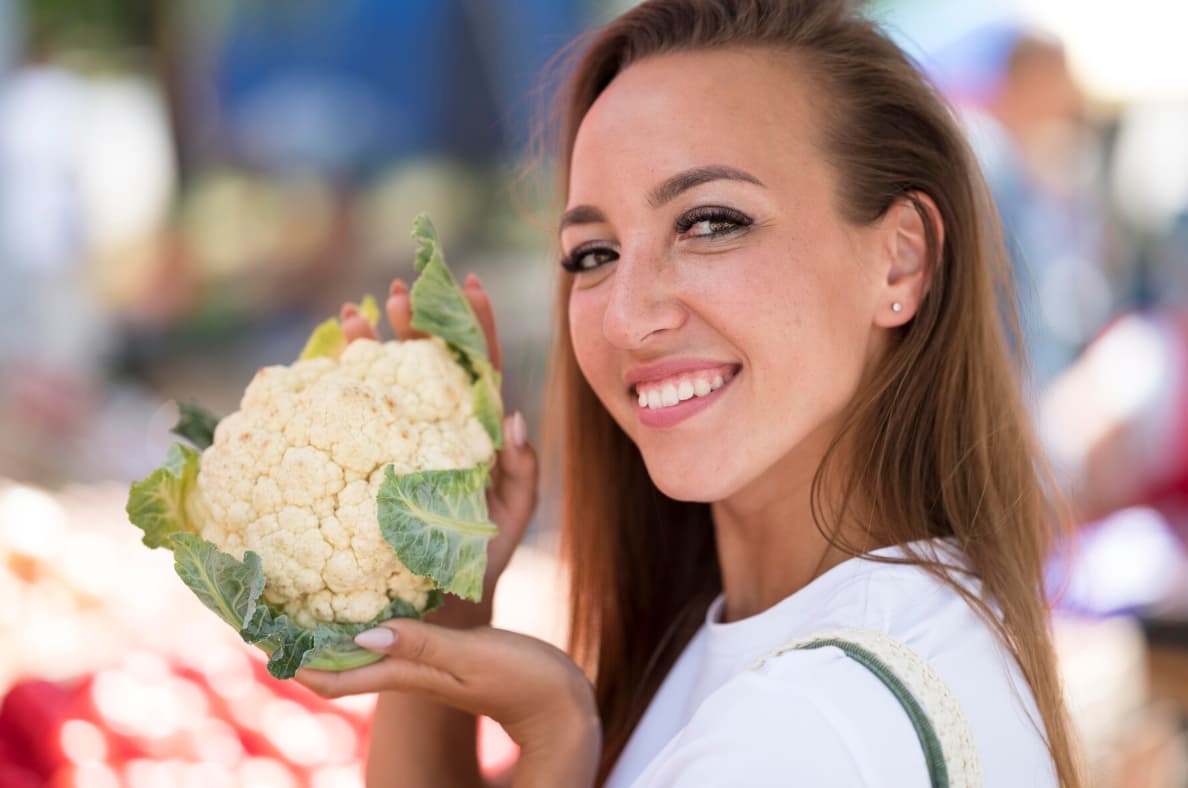Storing cauliflower properly is essential to maintain its freshness, prevent discoloration, and avoid unpleasant odors. This versatile vegetable can quickly turn from crisp and white to brown and smelly if not handled correctly.
The key to preserving cauliflower lies in managing moisture and temperature. Excess moisture encourages mold growth and bacterial proliferation, leading to that dreaded black appearance and foul smell.
On the other hand, too little moisture can cause the florets to dry out and lose their appealing texture.
To strike the right balance, start by selecting a fresh cauliflower head at the market. Look for compact, creamy-white florets without any brown spots or signs of decay.
Once home, resist the urge to wash the cauliflower immediately. Instead, store it unwashed in a loosely sealed plastic bag in the refrigerator’s crisper drawer. This method allows for some air circulation while preventing excessive moisture loss.
For longer-term storage, consider wrapping the cauliflower in a damp paper towel before placing it in a perforated plastic bag. This technique helps maintain humidity without promoting bacterial growth.
Remember to check on your cauliflower every few days, removing any florets that show signs of spoilage to prevent it from spreading.
How to Store Cauliflower?

By following these simple steps, you can extend the life of your cauliflower, keeping it fresh, white, and odor-free for up to a week or more.
This ensures you’ll have crisp, delicious cauliflower ready for your next culinary creation.
What’s So Great About Cauliflower?
Cauliflower is like the superhero of veggies. It’s packed with good stuff that helps your body stay healthy.
Here are some reasons why cauliflower is awesome:
- It’s full of vitamins and minerals.
- It helps your brain work better.
- It’s good for your heart.
- You can eat it in lots of different ways.
People are getting creative with cauliflower these days. You might have seen things like:
- Cauliflower pizza crust
- Cauliflower rice
- Cauliflower gnocchi
But you know what? Cauliflower is just as tasty when you keep it simple. You can roast it, bake it, steam it, or grill it. It’s all good!
Picking the Perfect Cauliflower
Before we talk about storing cauliflower, let’s make sure you know how to pick a good one at the store. Here’s what to look for:
- Color: The head should be cream-colored. No brown spots!
- Firmness: It should feel firm when you touch it.
- Leaves: Look for bright green, crisp leaves. They shouldn’t be wilted.
- Smell: A fresh cauliflower shouldn’t smell like anything. If it smells funny, it’s probably going bad.
Now that you know how to pick a good cauliflower, let’s talk about how to keep it fresh at home.
How to Store Whole Cauliflower?
Got a whole head of cauliflower? Great! Here’s how to keep it fresh:
- Loosen up: If your cauliflower came in plastic wrap, loosen it a bit. This lets air flow around the veggie.
- Bag it up: You can put the cauliflower in a new plastic bag with holes, or wrap it loosely in plastic wrap.
- Stem side up: Always store your cauliflower with the stem facing up.
- Chill out: Put it in the crisper drawer of your fridge.
By doing these simple steps, your whole cauliflower can stay fresh for up to 10 days!
How to Store Cut Cauliflower?
Maybe you bought pre-cut cauliflower, or you cut it up yourself. Either way, here’s how to keep those florets fresh:
- Dry it off: Use a paper towel or kitchen towel to pat each piece dry.
- Container time: Put the dry florets in a container that seals tight, or a plastic bag with holes.
- Keep it cool: Store it in the fridge.
Cut cauliflower doesn’t last as long as a whole head. It’ll stay good for about 5 days in the fridge.
How to Freeze Cauliflower?
Want to keep cauliflower even longer? Freeze it! Here’s how:
- Wash and cut: Clean the cauliflower and cut it into small pieces.
- Boil it: Put the pieces in boiling water for 2 minutes. This is called blanching.
- Ice bath: Right after boiling, put the cauliflower in a bowl of ice water. This stops it from cooking more.
- Dry off: Pat the cauliflower dry with a towel.
- Freeze: Spread the pieces on a baking sheet and freeze them for a few hours.
- Bag it: Once frozen, put the pieces in a freezer bag or container.
- Label it: Write the date on the bag.
Frozen cauliflower can last up to 8 months!
Thawing Frozen Cauliflower
When you’re ready to use your frozen cauliflower, you have a few options:
- Slow thaw: Put it in the fridge for a few hours or overnight.
- Quick thaw: Leave it on the counter for a few hours.
- Super quick thaw: Microwave it for about 10 seconds.
Cooking with Thawed Cauliflower
Once your cauliflower is thawed, you can use it in lots of ways:
- Steam it for a simple side dish
- Add it to a salad
- Make cauliflower rice
- Use it in soups or stews
How Long Does Cauliflower Last?
Here’s a quick guide to how long cauliflower stays fresh:
| Type of Cauliflower | Storage Method | How Long It Lasts |
| Whole head | Refrigerator | Up to 10 days |
| Cut florets | Refrigerator | About 5 days |
| Any | Freezer | Up to 8 months |
Remember, these times are for cauliflower stored the right way. If you don’t store it properly, it won’t last as long.
Signs Your Cauliflower Has Gone Bad
How do you know if your cauliflower isn’t good anymore? Look out for these signs:
- Brown spots: A few tiny ones are okay, but lots of big ones mean it’s time to toss it.
- Smell: If it smells bad, don’t eat it.
- Soft spots: Fresh cauliflower should be firm all over.
- Mold: Any sign of mold means it’s gone bad.
If you see any of these signs, it’s best to throw the cauliflower away.
Cooking with Cauliflower
Now that you know how to store cauliflower, let’s talk about some yummy ways to eat it!
Simple Roasted Cauliflower
This is a super easy way to make cauliflower taste great:
- Cut the cauliflower into small pieces.
- Toss the pieces with olive oil, salt, and pepper.
- Spread them on a baking sheet.
- Roast in the oven at 425°F (220°C) for about 25 minutes.
Cauliflower Rice
Want to try something different? Make cauliflower rice:
- Cut cauliflower into small pieces.
- Put the pieces in a food processor.
- Pulse until the cauliflower looks like rice.
- Cook the “rice” in a pan with a little oil for about 5 minutes.
You can use cauliflower rice just like regular rice. It’s a great way to eat more veggies!
Cauliflower Soup
Here’s an easy recipe for a creamy cauliflower soup:
- Cook chopped onions in a pot with butter.
- Add cauliflower florets and chicken broth.
- Simmer until the cauliflower is soft.
- Blend the mixture until smooth.
- Stir in some cream and season with salt and pepper.
Health Benefits of Cauliflower [Source]
Cauliflower isn’t just tasty – it’s really good for you too! Here are some reasons to eat more cauliflower:
- Low in calories: A cup of cauliflower has only about 25 calories.
- High in fiber: This helps your digestion and makes you feel full.
- Lots of vitamins: It’s packed with vitamin C, vitamin K, and B vitamins.
- Antioxidants: These help protect your body from damage.
- May help fight cancer: Some studies suggest cauliflower might help prevent certain types of cancer.
Fun Facts About Cauliflower
Did you know…?
- Cauliflower comes in different colors: white, purple, green, and orange.
- It’s related to broccoli, cabbage, and kale.
- The white part of cauliflower is called the “curd”.
- Cauliflower can grow to be over a foot wide!
More Ways to Use Cauliflower
Cauliflower is super versatile. Here are some more ideas for using this awesome veggie:
- Cauliflower steaks: Cut thick slices from a whole head and roast them.
- Cauliflower mash: Boil and mash cauliflower as a low-carb alternative to mashed potatoes.
- Cauliflower pizza crust: Blend cauliflower with cheese and eggs to make a crust.
- Buffalo cauliflower: Coat florets in hot sauce and bake for a spicy treat.
- Cauliflower tacos: Roast cauliflower with taco seasoning and use it as a taco filling.
- Cauliflower curry: Add cauliflower to your favorite curry recipe.
- Cauliflower mac and cheese: Use cauliflower instead of or along with pasta.
Growing Your Cauliflower
Want to try growing cauliflower at home? Here are some tips:
- Choose the right time: Cauliflower likes cool weather. Plant in early spring or late summer.
- Pick a sunny spot: Cauliflower needs at least 6 hours of sun each day.
- Prepare the soil: Mix in some compost to give your plants nutrients.
- Give them space: Plant seedlings about 18-24 inches apart.
- Water regularly: Keep the soil moist but not soggy.
- Be patient: It takes about 2-3 months for cauliflower to be ready to harvest.
Growing your cauliflower can be fun and rewarding. Plus, you’ll always have fresh cauliflower on hand!
Cauliflower in Different Cuisines
Cauliflower is used in many types of cooking around the world. Here are some examples:
- Indian: Aloo Gobi (cauliflower and potato curry)
- Italian: Cavolfiore Fritto (fried cauliflower)
- Middle Eastern: Zahra Mekleyah (roasted cauliflower with tahini)
- Chinese: Kung Pao Cauliflower
- Mexican: Coliflor al Mojo de Ajo (garlic cauliflower)
Try cooking cauliflower in different styles to discover new flavors!
Cauliflower vs. Broccoli
Cauliflower and broccoli are both part of the same plant family. They’re similar in many ways, but there are some differences:
| Cauliflower | Broccoli |
| Usually white | Usually green |
| Milder flavor | Stronger flavor |
| Smoother texture | More tree-like texture |
| Slightly fewer calories | Slightly more protein |
Both are super healthy and can be used in many of the same recipes.
Cauliflower for Special Diets
Cauliflower is great for many types of diets:
- Low-carb/Keto: Cauliflower is low in carbs and can replace high-carb foods like rice or potatoes.
- Vegan/Vegetarian: It’s a versatile vegetable that can be the star of many meatless dishes.
- Gluten-free: Cauliflower doesn’t contain gluten, making it safe for people with celiac disease or gluten sensitivity.
- Paleo: As a vegetable, cauliflower fits well into paleo diets.
Cauliflower in Processed Foods
Cauliflower is becoming popular in packaged foods too. You might see:
- Cauliflower pizza crusts
- Cauliflower rice in frozen food sections
- Cauliflower crackers or chips
- Cauliflower-based veggie burgers
While these can be convenient, remember that whole, fresh cauliflower is usually the healthiest option.
Frequently Asked Questions About Cauliflower
Got questions? We’ve got answers!
- Q: Can I eat cauliflower leaves?
A: Yes! The leaves are edible and nutritious. Try roasting them with olive oil and salt.
- Q: Why does my cauliflower smell bad when I cook it?
A: Cauliflower contains sulfur compounds that can smell when cooked. To reduce the smell, try cooking it for less time or adding a splash of vinegar to the cooking water.
- Q: Is frozen cauliflower as healthy as fresh?
A: Yes! Frozen vegetables are usually picked at their peak and frozen quickly, which preserves their nutrients.
- Q: Can I eat cauliflower raw?
A: Absolutely! Raw cauliflower is crunchy and tasty. It’s great in salads or as a snack with dip.
- Q: How do I know if a whole cauliflower is fresh when buying?
A: Look for a firm, compact head with tight florets. The leaves should be fresh and green, not wilted. Avoid any with brown spots or a strong smell.
- Q: Can I regrow cauliflower from scraps?
A: Unlike some vegetables, cauliflower doesn’t regrow well from scraps. It’s best to start with seeds or seedlings.
- Q: Is cauliflower keto-friendly?
A: Yes! Cauliflower is low in carbs and high in fiber, making it a great choice for keto diets.
- Q: How can I make cauliflower taste better?
A: Try roasting it with olive oil and spices, or mashing it with butter and garlic. You can also try different cooking methods like grilling or stir-frying.
- Q: Can I feed cauliflower to my dog?
A: Yes, in moderation. Cauliflower is safe for dogs to eat, but too much might upset their stomach.
- Q: Does cooking cauliflower destroy its nutrients?
A: Some nutrients are lost during cooking, but many remain. Steaming or microwaving cauliflower tends to preserve more nutrients than boiling.
Conclusion:
Wow, we’ve covered a lot about cauliflower! From storing it properly to cooking it in tasty ways, cauliflower is a veggie that’s worth getting to know.
It’s healthy, versatile, and can last a long time when you store it right.
Remember the key points:
- Store whole cauliflower in a ventilated bag in the fridge.
- Keep cut cauliflower dry and in an airtight container.
- Freeze cauliflower for long-term storage.
- Use your senses to check if cauliflower has gone bad.
- Try different ways of cooking cauliflower to find your favorite.
Whether you’re roasting it, ricing it, or using it in a creative new recipe, cauliflower is a veggie that can do it all.
So next time you’re at the grocery store, pick up a head of cauliflower and give some of these ideas a try. Your taste buds (and your body) will thank you!



